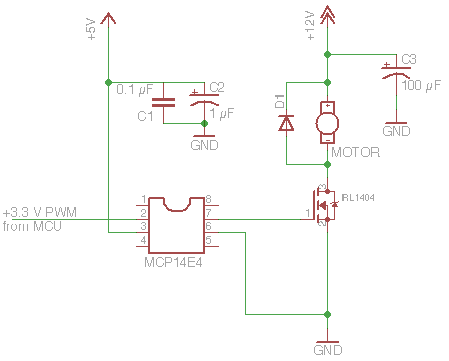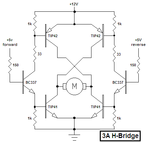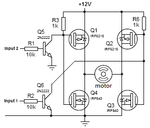Seabottom
Newbie level 5
Somehow, the mods deleted both double posts when a merge was attempted.....
I got a DC motor that runs at 12v, Load 1,58A and Stalled 2A
My controller spits out a 9v PWM signal.
I want my DC Motor to work at 12v with the PWM signal from the controller, basically increasing the voltage by 3v and keeping the same attributes of the controller.
I need to amplify the signal and for that I was told to use a mosfet instead of a transistor.
I was also given this pic

Now, what I don't understand is:
- Where is the +5v source coming from? Do I need it?
- What does it mean when the capacitor is curved? Google says it doesn't matter
- Do I need 2x mosfets in order for this to work? I'm thinking of the MCP14E4 and the IRL1404.
I also want to be able to change directions. In fact, this is essential for my application to work.
The control unit I have simply reverses the polarity and I was thinking that maybe I could put in a diode to enable the forward circuit and another diode for the backward circuit.
I'd also need to brake the motors, I thought of using a transistor and simply connecting it "backwards" so that when the controller is NOT sending out a signal, the motors wires will be shorted.
I would love to try and build this before getting the actual components but I can't seem to find a proper simulator for it. I think I clicked like 10 or 15 links on google.
I got a DC motor that runs at 12v, Load 1,58A and Stalled 2A
My controller spits out a 9v PWM signal.
I want my DC Motor to work at 12v with the PWM signal from the controller, basically increasing the voltage by 3v and keeping the same attributes of the controller.
I need to amplify the signal and for that I was told to use a mosfet instead of a transistor.
I was also given this pic

Now, what I don't understand is:
- Where is the +5v source coming from? Do I need it?
- What does it mean when the capacitor is curved? Google says it doesn't matter
- Do I need 2x mosfets in order for this to work? I'm thinking of the MCP14E4 and the IRL1404.
I also want to be able to change directions. In fact, this is essential for my application to work.
The control unit I have simply reverses the polarity and I was thinking that maybe I could put in a diode to enable the forward circuit and another diode for the backward circuit.
I'd also need to brake the motors, I thought of using a transistor and simply connecting it "backwards" so that when the controller is NOT sending out a signal, the motors wires will be shorted.
I would love to try and build this before getting the actual components but I can't seem to find a proper simulator for it. I think I clicked like 10 or 15 links on google.



